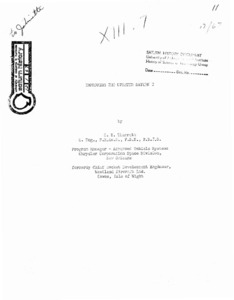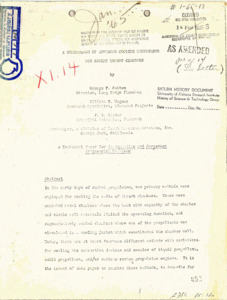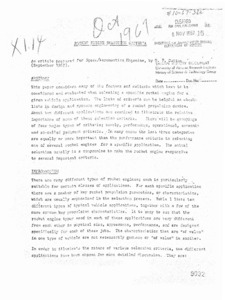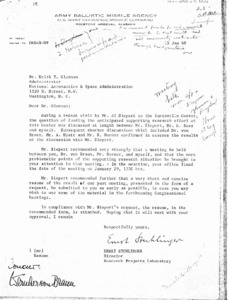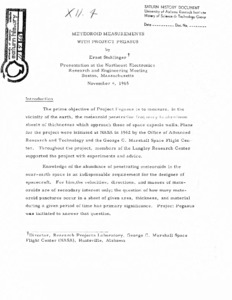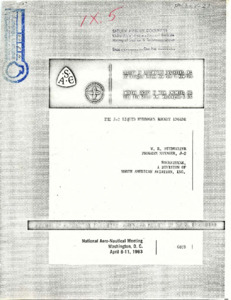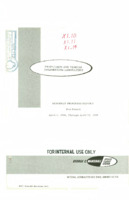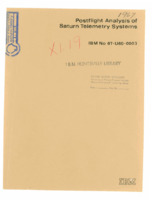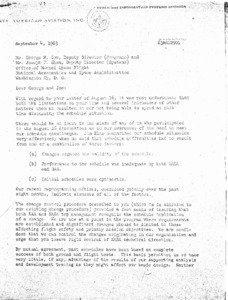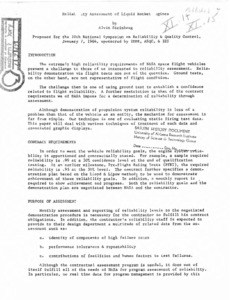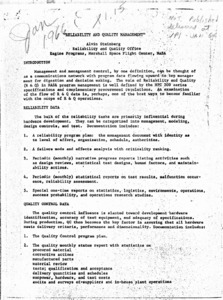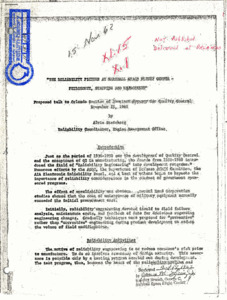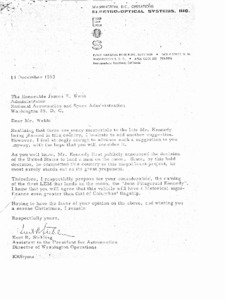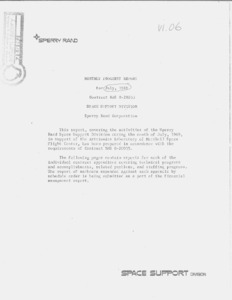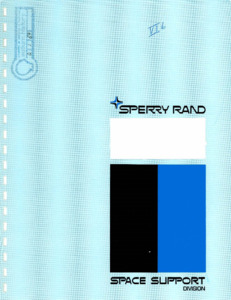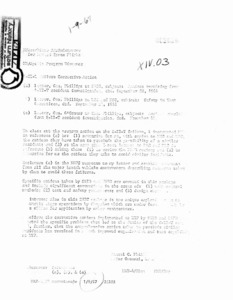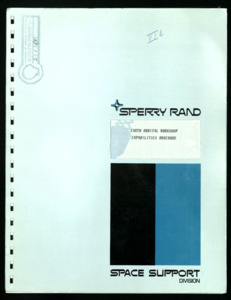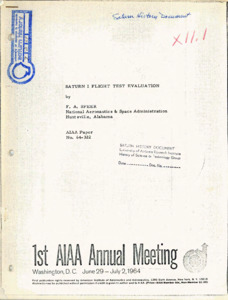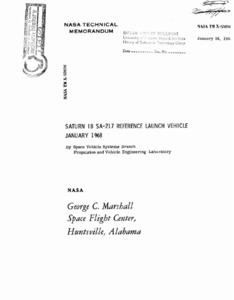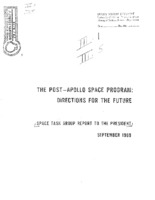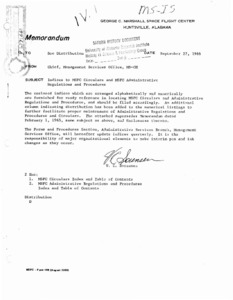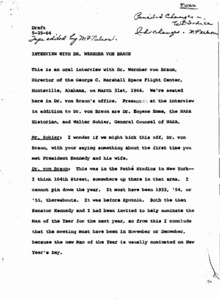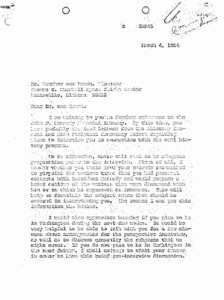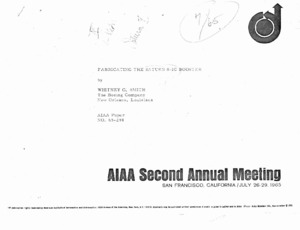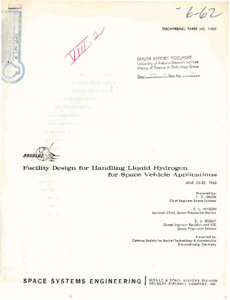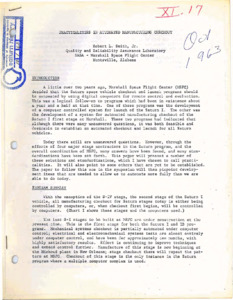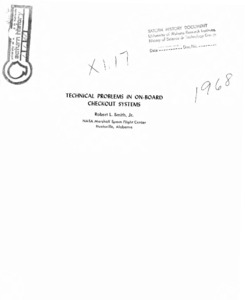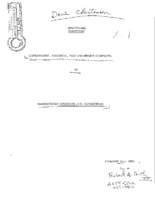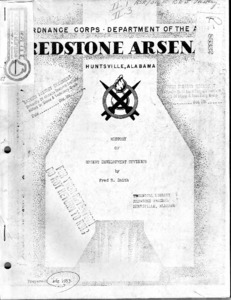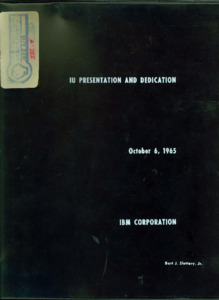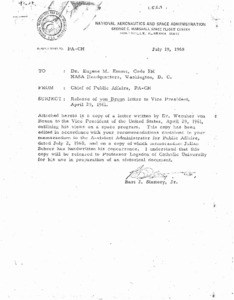
Browse Items (970 total)
Sort by:
-
"Improving the Uprated Saturn I."
This paper discusses five improved versions of the Uprated Saturn I that were studied by the Chrysler Corporation Space Division, supported by the Douglas Aircraft Corporation. -
"Saturn technical information handbook. Volume III of four volumes : SA-203."
The "Saturn Technical Information Handbook" provides up-to-date reference material to the Launch Operations Center personnel. This material shows the assembly and operation of the Saturn Vehicle components for systems analysis.; Volume II is available on the NASA Technical Reports Server (NTRS) as a PDF. -
"A Comparison of Advanced Cooling Techniques for Rocket Thrust Chambers".
The document is a technical paper for Astronautics and Aerospace Engineering Magazine.The copy has handwritten notes that appear to be for revisions. The abstract states "In the early days of rocket propulsion, two primary methods were employed for cooling the walls of thrust chambers. These were uncooled metal chambers where the heat sink capacity of the chamber and nozzle wall materials limited the operating duration, and regeneratively cooled chambers where one of the propellants was circulated in a cooling jacket which constituted the chamber wall. Today, there are at least fourteen different methods with variations for cooling the combustion devices and nozzles of liquid propellant, solid propellant, and/or nuclear rocket propulsion engines. It is the intent of this paper to examine these methods, to describe for each the useful range of operating conditions, as well as present and likely future applications, to define their limitations and associated problems. Emphasis is primarily placed on liquid rocket engines." -
"Rocket engine selection criteria."
This paper considers many of the factors and criteria which have to be considered and evaluated when selecting a specific rocket engine for a given vehicle application. The lists of criteria can be helpful as checklists in design and systems engineering of a rocket propulsion device. About ten different applications are examined to illustrate the relative importance of some of these selection criteria. There will be groupings of our major types of criteria; namely, performance, operational, economic and so-called judgment criteria. In many cases the last three categories are equally or more important than the performance criteria in selecting one of several rocket engines for a specific application. The actual selection usually is a compromise to make the rocket engine responsive to several important criteria. -
"A comparison of four control systems proposed for Saturn V launch vehicles."
Presented are the results of a study comparing four proposed control systems for the first stage flight of Saturn V launch vehicles. The primary basis of comparison is the effect on structural loads, using the bending moments at three stations as load indicators. Two of the systems sense only the vehicle attitude and attitude rate, while the other two systems also sense the lateral acceleration. A yaw plane wind response analysis, including rigid body translation, rigid body rotation, four bending modes, five slosh modes, and a non ideal control system, was performed. The winds used in the study were the Marshall synthetic profile and three selected Jimsphere-measured real wind profiles. Load relief obtained from the addition of accelerometer feedback in the control loop amounted to about 10 percent at maximum bending moment station. In view of predicted structural capabilities of the vehicle, this reduction in loads was not considered sufficient to offset the added complexity and the slight reduction in rigid body stability . -
"Army Participation in the National Satellite and Space Program."
This paper, which was presented at a Semi-Annual Meeting of the American Rocket Society, traces the role of the United States Army in national space activities. Incorporated in the report are photographs illustrating the evolution of the satellite and space program. -
"Letter to Dr. Keith T. Glennan."
Letter to Kieth T. Glennan from Ernst Stuhlinger regarding a potential meeting between Glennan, Wernher von Braun Horner and Ernst himself. Attached is a required resume. -
"Meteoroid measurements with Project Pegasus."
Presentation at the Northeast Electronics Research and Engineering Meeting, Boston, Massachusetts, November 4, 1965. Ernest Stuhlinger, Director, Research Projects Laboratory, George C. Marshall Space Flight Center (NASA), Huntsville, Alabama.; INTRODUCTION: The prime objective of Project Pegasus is to measure, in the vicinity of the earth, the meteoroid penetration frequency in aluminum sheets of thicknesses which approach those of space capsule walls. Plans for the project were initiated at NASA in 1962 by the Office of Advanced Research and Technology and the George C. Marshall Space Flight Center. Throughout the project, members of the Langley Research Centers supported the project with experiments and advice. -
"Space flight projects - today and tomorrow."
NASA symposium on scientific and technical Information. -
"The J-2 Liquid Hydrogen Rocket Engine."
The 5-2 high-energy liquid propellant rocket engine (~i~. l), a large engine producing 200,000 pounds of thrust at altitude conditions, burns liquid hydrogen and liquid oxygen to produce the necessary high specific impulse for practical space use. Rocketdyne, a Division of North American Aviation, Inc., is developing the engine for the George C. Marshall Space Flight Center, Xfi. The first use of the engine will be in the upper stages of the Saturn vehicles. Five engines will be used for the second, S-I1 stage of the Saturn V, and one will power the S-IVB third stage of the Saturn V and S-ISTI second stage of 'the Saturn IB; Original is a photocopy on onion skin. -
Postflight Analysis of Saturn Telemetry Systems.
The abstract states "A telemetry system is a device to transfer information from an inaccessible to an accessible location. A constant input to a telemetry system yields outputs that are distributed according to some density function. A linear change in this constant input may yield a nonlinear change in output. The theory of statistics and experimental design may be applied to the data received from a flight to evaluate the inflight accuracy, linearity, and precision of various telemetry systems. This paper explains the analytical concepts used in postflight analysis of Instrument Unit telemetry systems. It also presents the method for interpreting the results of these analytical techniques." -
"Letter to Mr. George M. Low. and Joseph F. Shea."
Letter to George M. Lowe and Joseph F. Shea from H.A. Storms president continuing a conversation that was left unfinished. -
"Reliability assessment of liquid rocket engines."
Proposed for the 10th National Symposium on Reliability & Quality Control. This paper will deal with various techniques of treatment of such data and associated graphic displays. -
"Reliability and quality management."
The role of Reliability and Quality in NASA program management is well defined by the NPC 200 series and complimentary procurement regulations. -
"The reliability picture at Marshall Space Flight Center - philosophy, staffing and management. Proposed talk to Orlando Section American Society for Quality Control."
Document that discusses the importance of reliability in engineering. -
Letter to the Honorable James E. Webb, Administrator, National Aeronautics and Space Administration from Kurt R. Stehling.
A letter to Jame E. Webb proposing that the first LEM that lands on the moon to be named after President Kennedy." -
"Statistical model for Saturn electrical support equipment mission availability."
This report presents the logic leading to a mathematical expression for mission availability. Mission availability is treated as the probability that the cumulative downtime occurring during a mission of given length will be less than the time constraint. This is opposed to more general approaches such as steady state or instantaneous availability or operating time versus real time. We intend to present a practical and usable mathematical model by deduction and demonstration. The development is based on exponentially distributed downtimes. Experience shows that certain systems follow exponential downtime distributions except near zero. This error is often so small that it may be neglected. A future report will present a downtime distribution which will account for this small error. -
"The TV system for the Apollo telescope mount."
Focuses on the construction and future use of the Apollo space telescope. The components described in this paper except for those listed otherwise were designed by the Space Support Division of Sperry Rand Corporation to specifications established by NASA's Marshall Space Flight Center in Huntsville, Alabama. Appreciation is extended to MSFC for permission to publish this paper and for data and help provided for its preparation. -
"Sperry Rand monthly progress report for July, 1969."
The following pages contain reports for each of the individual contract appendices covering technical progress and accomplishments, related problems, and staffing progress. The report of manhours expended against each appendix by schedule order is being submitted as a part of the financial management report. -
"Earth Orbital Workshop Capabilities Brochure."
A brochure designed to depict a competence and capability in the area of large earth-orbital workshops. -
"Engineering Capabilities Presentation."
This Engineering Capabilities Presentation lists the competence and capability that has been demonstrated by the Space Support Division of Sperry Rand Corporation while fulfilling contractual commitments in the aerospace industry. This is a preliminary presentation; the preparation of a complete capabilities history of the division is currently in the developmental stage. The Capabilities Experience Summary is comprised of ten categories. e.g. Category 1 - Aeronautics, etc. The capabilities reported herein were performed by the Space Support Division under Contract NAS8-20055 to the National Aeronautics and Space Administration, George C. Marshall Flight Center, Astrionics Laboratory, Huntsville, Alabama. -
"Saturn I flight test evaluation."
As this paper is being written, the Saturn I flight test program includes five flights launched between October, 1961 and January, 1964. All five fiights were complete successes, both in achieving all major test missions and in obtaining an unprecedented volume of system performance data for flight analysis. -
"Saturn IB SA-217 reference launch vehicle."
This document contains a definition of a reference Saturn IB launch vehicle designated SA-217. The Saturn IB SA-217 is a projected reference vehicle, based on Saturn IB SA-212, incorporating the latest proposed product improvements. The two-stage payload capability of this vehicle to a 100-nautical-mile circular orbit is 44,965 pounds. The Saturn IB SA-217 launch vehicle is to be used as the baseline vehicle for advanced studies requiring the use of the standard or modified Saturn IB launch vehicle. This vehicle definition does not necessarily represent approved changes to any specific vehicle. This document supersedes the Saturn IB SA-213 reference Launch Vehicle, described in memorandum R-P&VE-DIR-65-92. -
The Post-Apollo Space Program: Directions for the Future.
The document is a Space Task Group report to the president. Pages 8, 18, 26, 27 of the document are missing. -
"Memorandum: Indices to MSFC circulars and MSFC Administration regulations and procedures from Chief Management Services Office."
Memorandum regarding indices ready for reference and filing. -
"Interview with Dr. Wernher von Braun."
Transcription of an interview with Wernher von Braun and Mr. Sohier. -
"Letter to Dr. Wernher von Braun."
Archive copy is a poor photocopy. Unable to read. -
"Fabricating the Saturn S-IC Booster."
AIAA Second Annual Meeting, San Francisco, California. Discusses the fabrication process of the Saturn S-IC booster. -
"Facility Design for Handling Liquid Hydrogen for Space Vehicle Applications."
Presented to German Society for Rocket Technology & Astronautics.Essay discussing the capabilities of liquid hydrogen as fuel. -
"Practicalities in automated manufacturing checkout."
This paper presents a number of solutions to a number of unanswered questions regarding the Saturn projects. -
"The Case for Compatibility."
"The Case for Compatibility" is a paper by Robert L. Smith, Jr., who worked in Quality and Reliability Assurance Laboratory at George C. Marshall Space Flight Center. The summary states, "Ever since the use of missiles and space launch vehicles began, questions have existed in every program regarding the similarity between upstream (e.g., manufacturing, static firing ) and launch site checkout equipment. Programs have existed which utilized nearly identical equipment for both uses; other programs have existed in which any resemblance of the equipment was probably coincidental. Many factors have entered the final decisions, not the least of which were economic and schedule considerations, and, in some instances, the organizational structure of the developer." -
"Technical problems in on-board checkout systems."
For the purposes of this paper, an onboard checkout system is defined as a system which is built into prime flight equipment, flies with it, and permits a checkout capability to exist during all the major phases of the test and mission life of that prime equipment. Varying degrees of capability may exist in such a system, depending on what is designed into it. This, in turn, is generally dependant on life and mission requirements of the prime equipment, degree of mission checkout required, reliability restrictions,redundancy levels, data management scheme, and equally important, state of the art . Not all checkout can be accomplished with onboard equipment. Mechanical system problems such as leak detection, for example, require techniques that cannot be remotely controlled and evaluated today. On the other hand, such things as in-flight telemetry have been used for quite a long time and will continue to be used for onboard checkout. -
Unofficial Directory: Government, Industry, and University Contacts in Management Research and Engineering.
The Preface states "This is a directory of industry, University, and Federal contacts who are involved in the areas of Management Science, Behavioral Science, Operations Research , Cybernetics, and Organizational Structure and Behavior. The listing represents a variety of disciplines -- Sociology, Psychology, Social Psychology, Psychiatry, Anthropology, Statistics, History, Public Administration, Political Science, Economics, Systems Analysis, Ecology,and General Systems Theory." -
"History of Rocket Development Division."
A document recounting the history of the Rocketdyne Development Division -
"Space Station operations analysis using Gemini-Titan II-Agena."
Copy No. 026. Ger-10866. -
"IU Presentation and Dedication."
This is a note book that contains newspaper articles and photographs about the new IBM building in Huntsville, Alabama. It also has information about the Instrument Unit for the first Saturn IB flight. There is also information about the Saturn IB Instrument Unit being barged to Kennedy Space Center.; There are 2 pages that list the articles with the title, newspaper name, writer and date.; There are six color photographs that show the dedication of the IBM building and the Instrument Unit. One photograph has Dr. Wernher von Braun standing behind the ring. Two of the photographs show the Instrument Unit on a trailer being pulled by a truck.; Preferred Citation: [Identification of item] Saturn V Collection, Dept. of Archives/Special Collections, M. Louis Salmon Library, University of Alabama in Huntsville, Huntsville, AL. -
"Memorandum to Dr. Eugene M. Emme, Code EH, NASA Headquarters, Washington, D. C. from Bart J. Slattery, Jr., Chief of Public Affairs."
Memorandum from NASA Chief of Public Affairs to Eugine M. Emme. States that a video from Wernher von Braun are included regarding his views on the NASA program.
